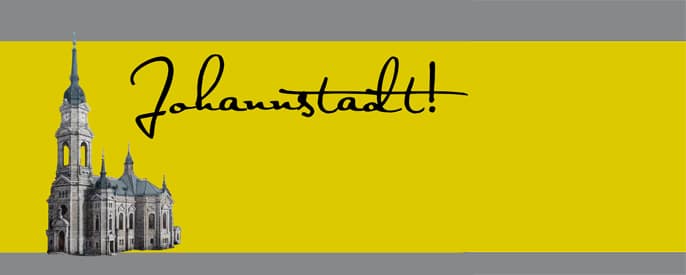Diese Seite ist mehrsprachig verfügbar: English, Русский, عربي.
Gehen Sie vom Johanngarten zurück zur Lili-Elbe-Straße und folgen Sie dieser nach links bis zur ehemaligen Schokoladenfabrik am Übergang der Fahrstraße in den Geh- und Radwegbereich. Hier erreichen Sie den Standort Nr. 3 des historischen Rundwegs.
Vor 1945: Schänke, Schwestern und Schokolade
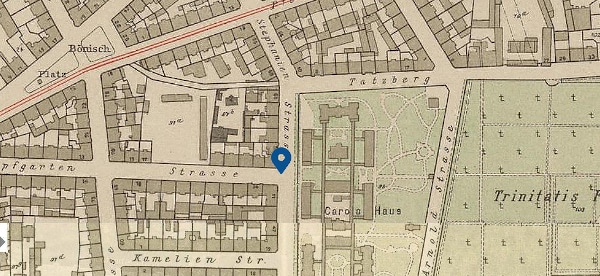
Beauharnais und Hopfgarten
Die früher hier verlaufende Stephanienstraße erhielt ihren Namen im Jahr 1876 zum Andenken an Stéphanie de Beauharnais (1789–1860), Großherzogin von Baden, Adoptivtochter von Napoléon Bonaparte und Großmutter der Sächsischen Königin Carola. Der Straßenabschnitt zwischen Tatzberg und Elbe wurde 1937 in Mackensenstraße nach dem preußischen Generalfeldmarschall August von Mackensen (1849–1945) geändert. 1945 erfolgte die erneute Umbenennung in Pfeifferhannsstraße in Erinnerung an den Zisterziensermönch und Bauernführer Heinrich Pfeiffer (geboren vor 1500; hingerichtet 1525). Die 1895 angelegte Hopfgartenstraße erhielt ihren Namen nach dem hier befindlichen Vorwerk des sächsischen Vizekanzlers Graf Georg Wilhelm von Hopffgarten (1739–1813). Das später in der Nähe angelegte Lokal „Hopfgartens“ wurde zu einem beliebten Ausflugsort.
Carolahaus und Albertverein
Östlich der Stephanienstraße befand sich das Gelände des Carolahauses, einem 1878 eröffneten Krankenhaus. Es bestand aus einem Hauptgebäude, zwei Bettenhäusern, vier um einen grünen Innenhof gruppierten Pavillons und den zugehörigen Wirtschaftseinrichtungen. Das Areal erstreckte sich mit seinen Außenanlagen von der heutigen Gerokstraße bis zum Tatzberg. Der Albertverein, ein 1867 auf Initiative von Prinzessin Carola von Sachsen gegründeter und nach ihrem Ehegatten Prinz Albert benannter Frauenverein des Roten Kreuzes, betrieb das Krankenhaus. In Kriegszeiten widmete sich der Verein der Pflege der Verwundeten – in Friedenszeiten der Armenpflege. Neben dem Krankenhausbetrieb mit insgesamt 80 Betten diente die Einrichtung auch der Weiterbildung der auf Lebenszeit beschäftigten Albertinerinnen.
Weitere Informationen zum Carolahaus finden Sie hier.
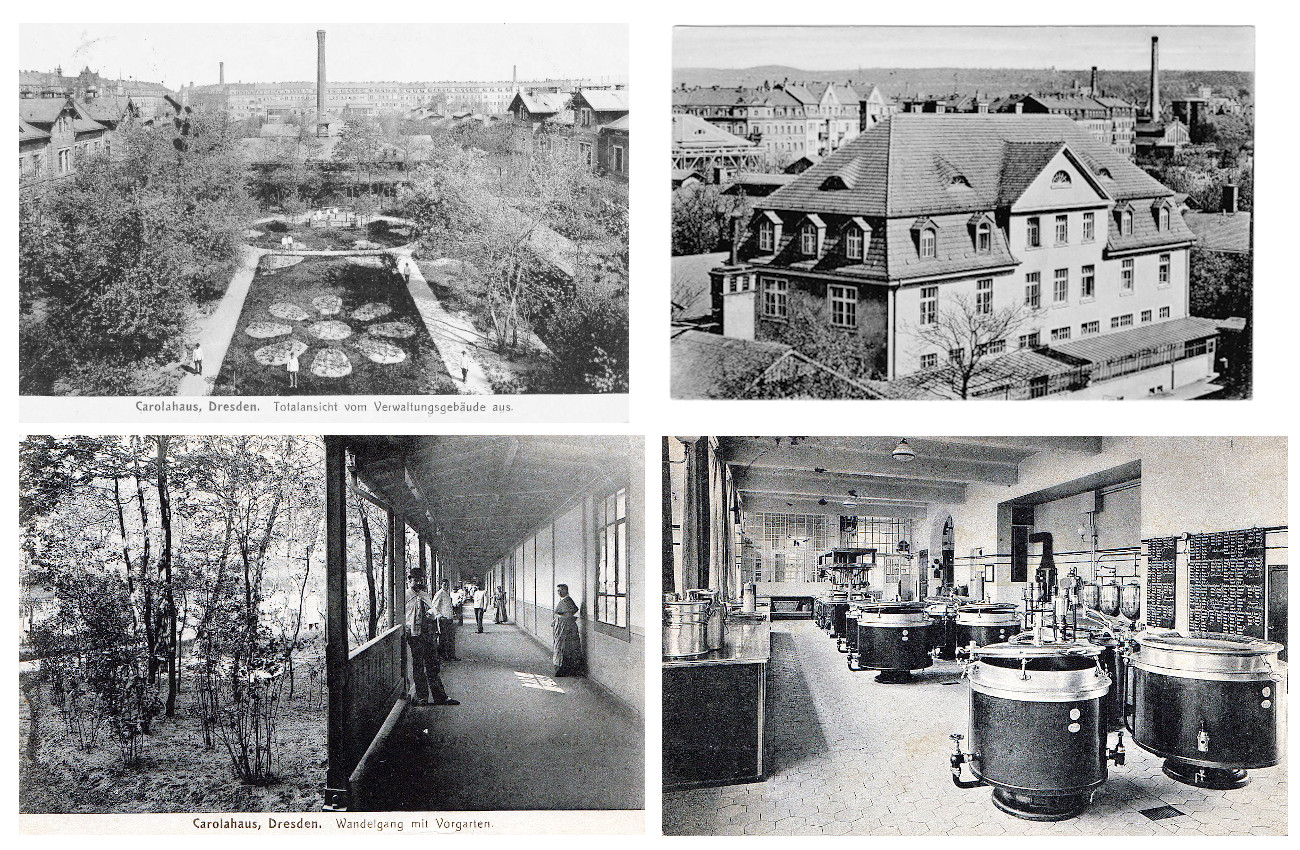
Schokolade und Familie Clauß
Schokolade und Familie Clauß 1917 verlegte der Zuckerwarenfabrikant Bruno E. Clauß (1872–1930) die nach ihm benannte und 1914 gegründete Schokoladenfabrik aus der Leipziger Vorstadt auf die Grundstücke an der Hopfgartenstraße 28 und der Stephanienstraße 49. Um Süßwaren zu erschwinglichen Preisen anbieten zu können, importierte die Firma Kakao, Tee und Kaffee direkt aus den Herkunftsländern und vermarktete ihre Produkte über eigene Geschäfte und Lastwagen. In der Fabrik und den Filialen arbeiteten bis 1943 rund 300 Angestellte. Ein Werksverkauf befand sich in der Elisenstraße 60, Ecke Hopfgartenstraße.
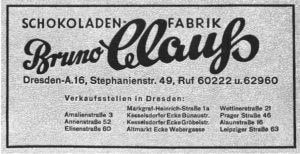
Nach 1945: Konstruktion, Kreatives und Kinderschutz
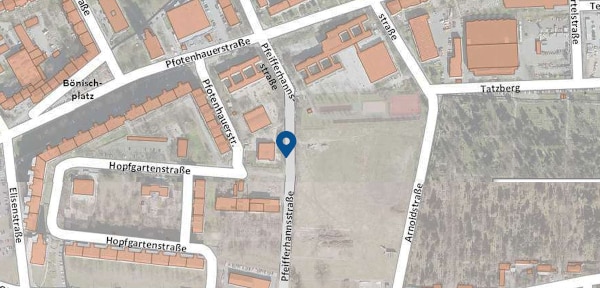
Das Dresdner Plattenwerk im Wandel
Ab Ende 1957 entstand auf dem 30.000 Quadratmeter großen Gelände des ehemaligen Carolahauses das Plattenwerk Johannstadt. Das mechanisierte Großblockwerk produzierte größtenteils unter freiem Himmel. Hier konnten erstmalig im Bezirk Dresden Großblöcke aus Ziegelsplittbeton im Fließbandverfahren hergestellt werden, die vorrangig aus Trümmerschutt, Asche und Beton bestanden. Damit wurde die serienmäßige Produktion von geschosshohen Platten möglich. Auch Betonprodukte wie Schwebedecken, Schienenplatten und Sonderelemente entstanden im Johannstädter Plattenwerk. Auf Druck einer Bürgerinitiative wurden im Jahr 2001 die baulichen Reste des Plattenwerks abgetragen. Die am südlichen Ende des Areals errichtete Skateranlage zog Jugendliche aus ganz Dresden und darüber hinaus an. 2019 wurde die Anlage durch die Eigentümer abgerissen. Ein 2006 in Kraft getretener Bebauungsplan sieht auf dem Grundstück die Errichtung einer Wohnbebauung vor.
Weitere Informationen zum ehemaligen Plattenwerk finden Sie hier.
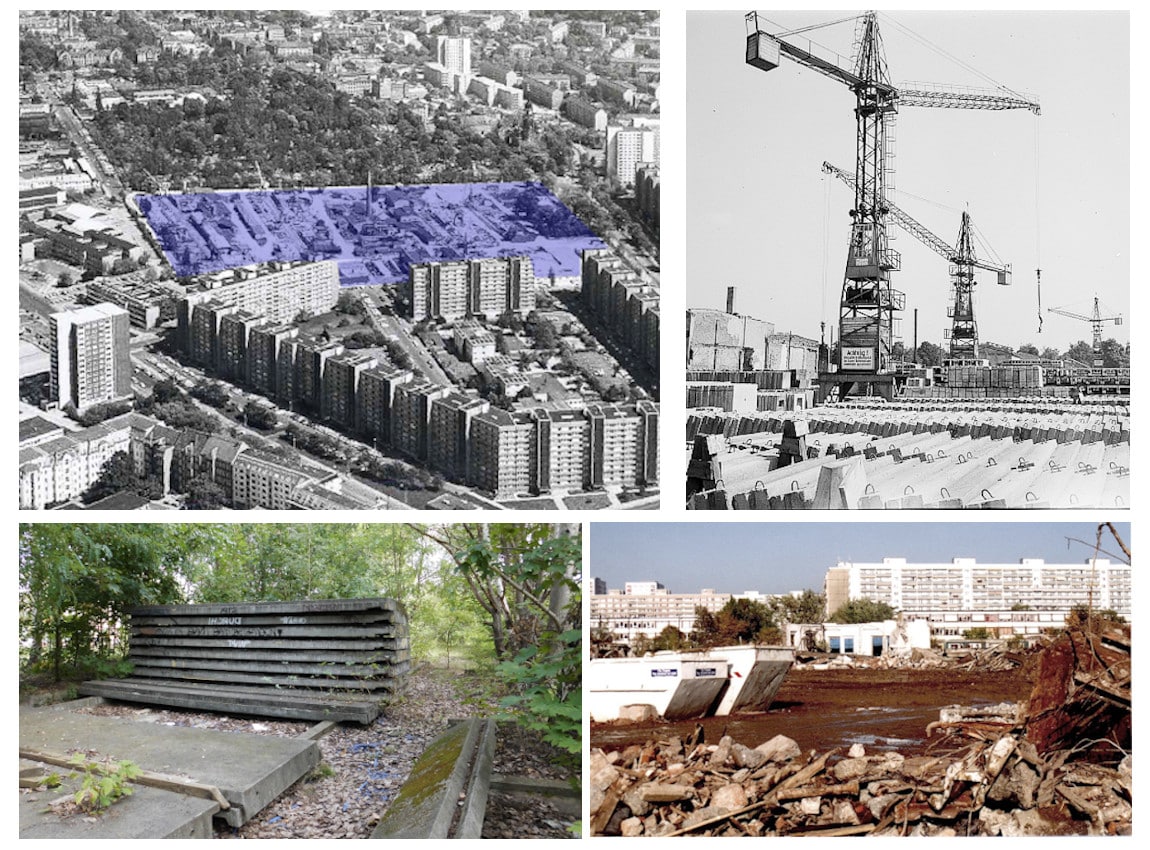
Aus Schokolade wurde Kreativwirtschaft und Kinderschutz
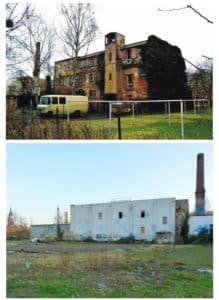
Unten: Östlicher Teil der ehemaligen Schokoladenfabrik,
2016. Foto: M. Kunert
Das rote Backsteingebäude der Schokoladefabrik überstand als einziges Gebäude der früheren Bebauung die Bombardements vom Februar 1945. Das Werk produzierte nach dem Krieg noch weitere acht Jahre, bis 1953 das Unternehmen enteignet und die Maschinen durch den VEB Elbflorenz übernommen wurden. Im Jahr 1954 zog in das Gebäude die Konstruktionsabteilung des VEB Karosseriewerk Dresden ein. Hier entstanden wesentliche Teile des Wartburg Tourist.
1996 erhielten die Erben von Bruno E. Clauß die Schokoladenfabrik zurück. Seit 1999 vermietete die Erbengemeinschaft den Bürotrakt des Gebäudes zu erschwinglichen Konditionen hauptsächlich an Studierende der Architektur. 2019 gründete sich der Schokofabrik e. V., der den westlichen Teil der Schokofabrik seitdem betreibt. 2020 befinden sich hier Künstlerateliers, Büros und ein Tonstudio. 2019 erwarb der Deutsche Kinderschutzbund den östlichen Gebäudeteil der Fabrik mit der ehemaligen Werkhalle, um aus diesem ein Integratives Familienzentrum zu entwickeln.
Text: Matthias Erfurth, Matthias Kunert, Henning Seidler
Redaktionsschluss: März 2021
Aktualisierung Onlineplattform: 2022 wurde die ehemalige Stephanienstraße zwischen Gerok- und Pfotenhauerstraße im Ergebnis einer intensiven Bürgerbeteiligung neu gestaltet. Der Abschnitt zwischen Gerok- und Pfeifferhannsstraße erhielt auf Beschluss des Stadtrats den Namen Lili-Elbe-Straße.
Weitere Informationen zur Straßengestaltung finden Sie hier.
